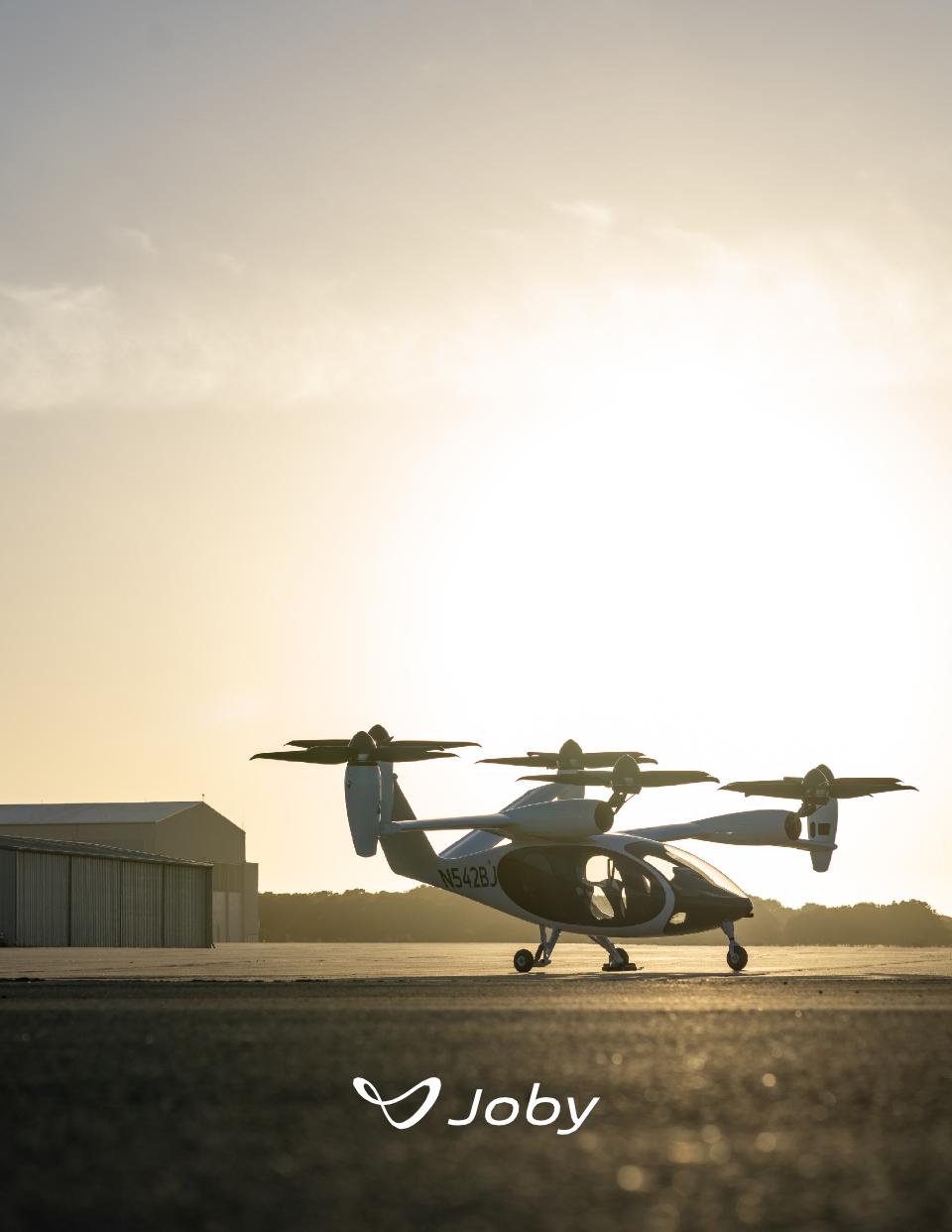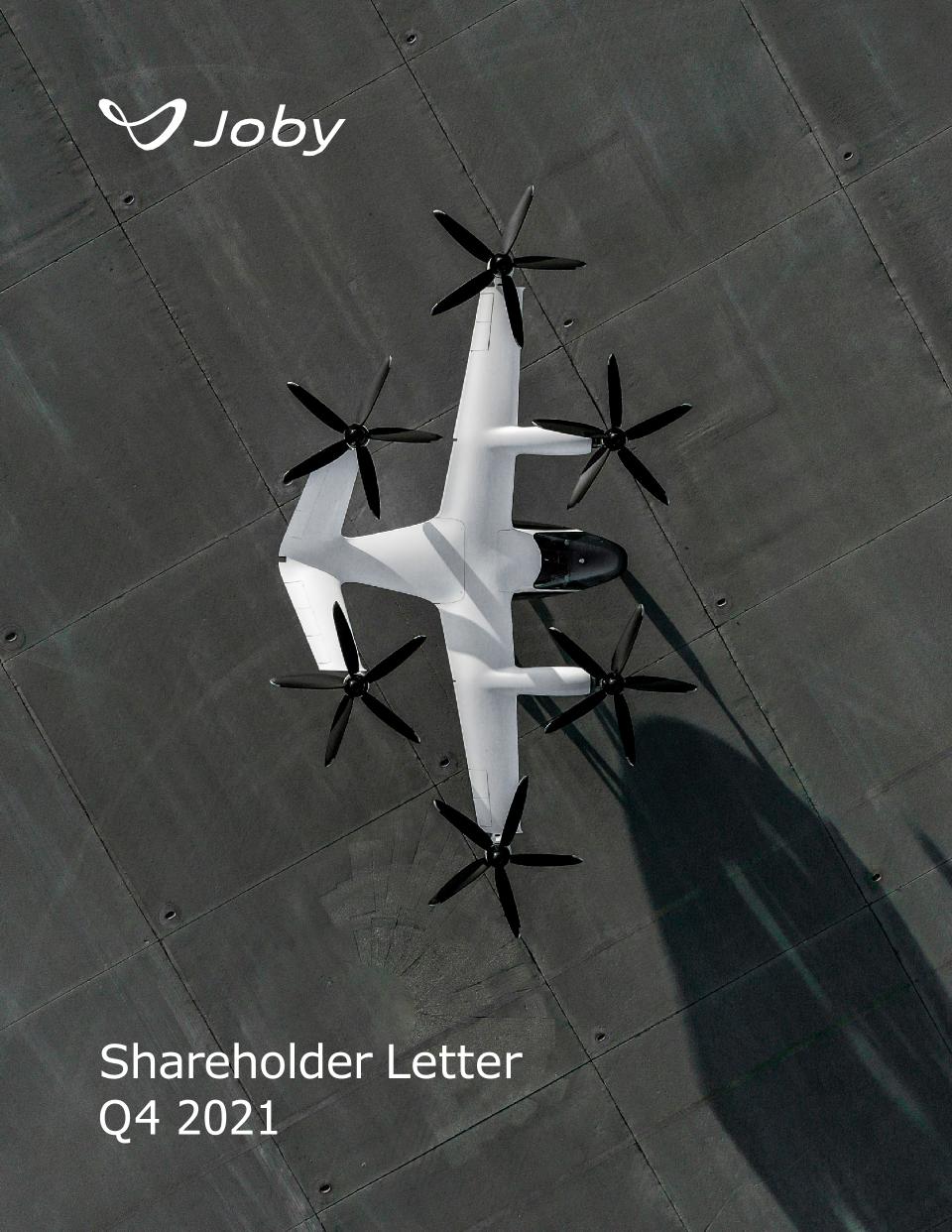

Shareholder Letter Q4 2021
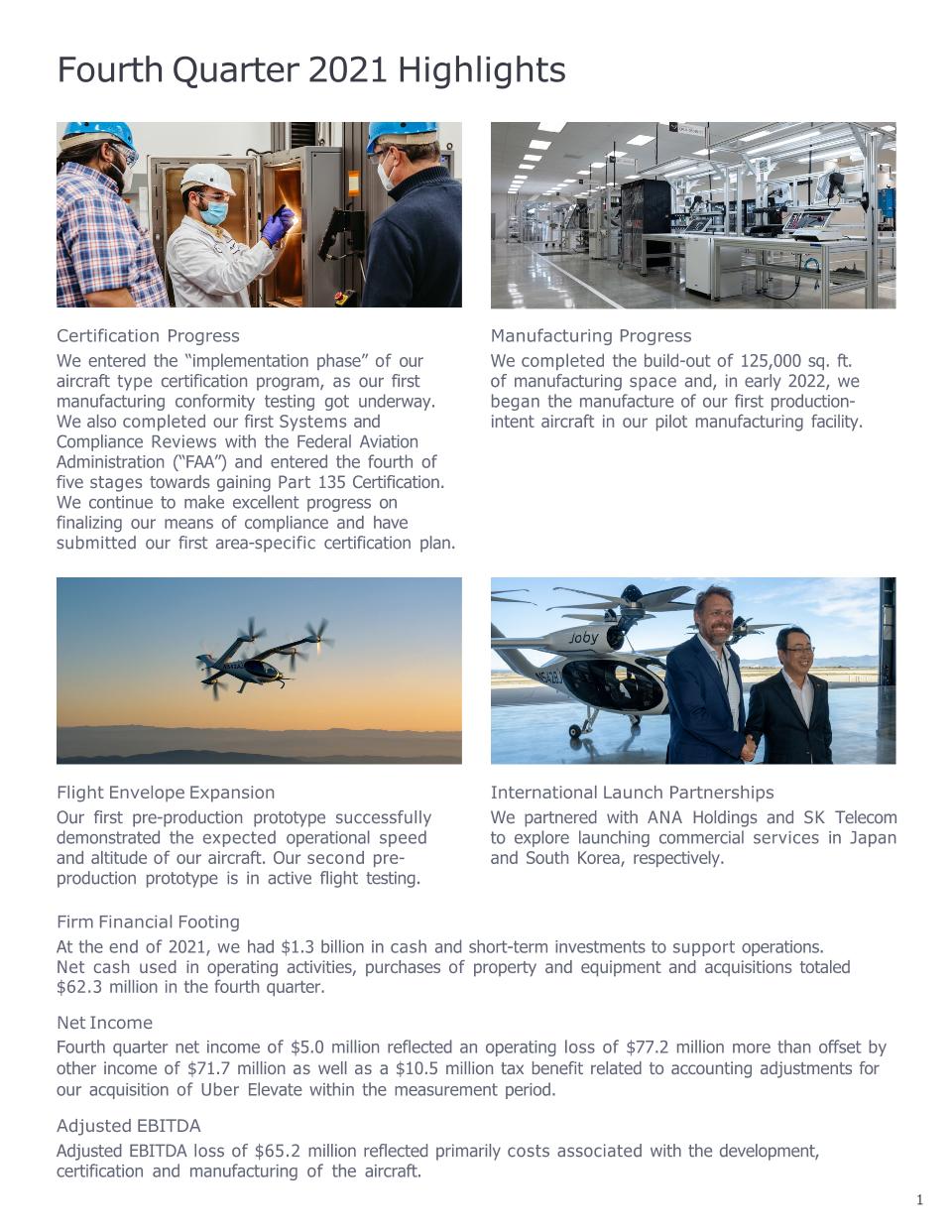
Fourth Quarter 2021 Highlights Certification Progress We entered the “implementation phase” of our aircraft type certification program, as our first manufacturing conformity testing got underway. We also completed our first Systems and Compliance Reviews with the Federal Aviation Administration (“FAA”) and entered the fourth of five stages towards gaining Part 135 Certification. We continue to make excellent progress on finalizing our means of compliance and have submitted our first area-specific certification plan. Flight Envelope Expansion Our first pre-production prototype successfully demonstrated the expected operational speed and altitude of our aircraft. Our second pre- production prototype is in active flight testing. Firm Financial Footing At the end of 2021, we had $1.3 billion in cash and short-term investments to support operations. Net cash used in operating activities, purchases of property and equipment and acquisitions totaled $62.3 million in the fourth quarter. Net Income Fourth quarter net income of $5.0 million reflected an operating loss of $77.2 million more than offset by other income of $71.7 million as well as a $10.5 million tax benefit related to accounting adjustments for our acquisition of Uber Elevate within the measurement period. Adjusted EBITDA Adjusted EBITDA loss of $65.2 million reflected primarily costs associated with the development, certification and manufacturing of the aircraft. International Launch Partnerships We partnered with ANA Holdings and SK Telecom to explore launching commercial services in Japan and South Korea, respectively. Manufacturing Progress We completed the build-out of 125,000 sq. ft. of manufacturing space and, in early 2022, we began the manufacture of our first production- intent aircraft in our pilot manufacturing facility. 1
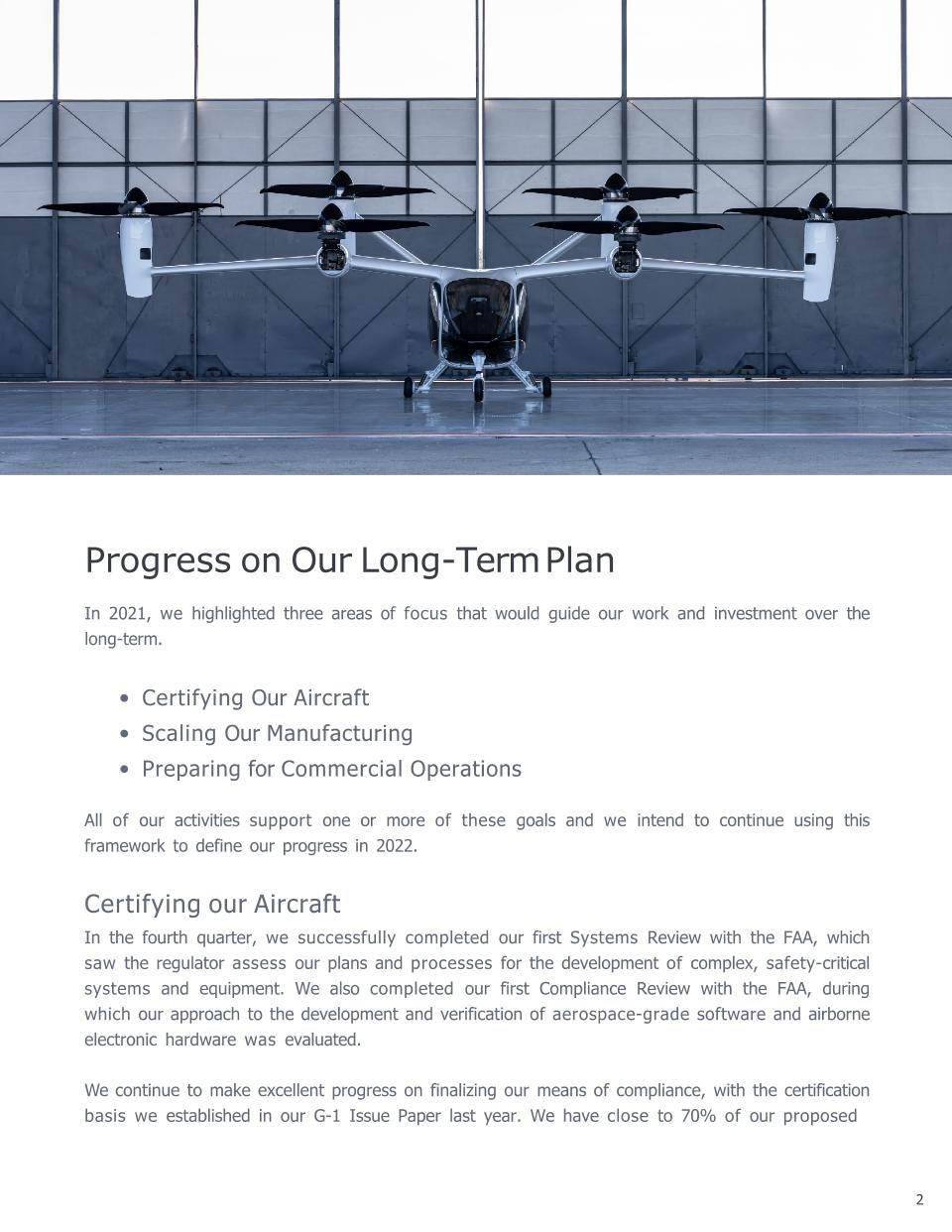
Progress on Our Long-Term Plan 2 In 2021, we highlighted three areas of focus that would guide our work and investment over the long-term. Certifying Our Aircraft Scaling Our Manufacturing Preparing for Commercial Operations All of our activities support one or more of these goals and we intend to continue using this framework to define our progress in 2022. Certifying our Aircraft In the fourth quarter, we successfully completed our first Systems Review with the FAA, which saw the regulator assess our plans and processes for the development of complex, safety-critical systems and equipment. We also completed our first Compliance Review with the FAA, during which our approach to the development and verification of aerospace-grade software and airborne electronic hardware was evaluated. We continue to make excellent progress on finalizing our means of compliance, with the certification basis we established in our G-1 Issue Paper last year. We have close to 70% of our proposed
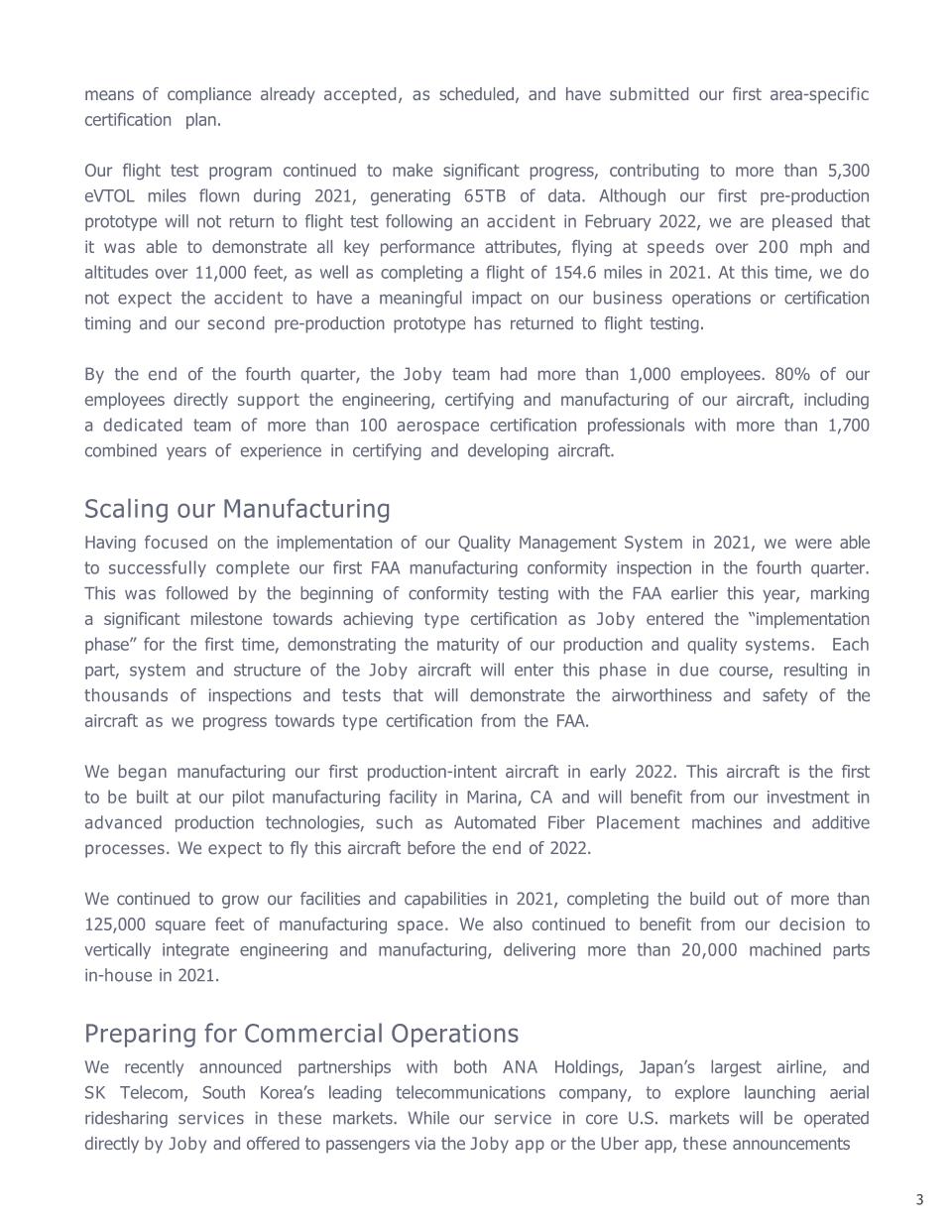
3 means of compliance already accepted, as scheduled, and have submitted our first area-specific certification plan. Our flight test program continued to make significant progress, contributing to more than 5,300 eVTOL miles flown during 2021, generating 65TB of data. Although our first pre-production prototype will not return to flight test following an accident in February 2022, we are pleased that it was able to demonstrate all key performance attributes, flying at speeds over 200 mph and altitudes over 11,000 feet, as well as completing a flight of 154.6 miles in 2021. At this time, we do not expect the accident to have a meaningful impact on our business operations or certification timing and our second pre-production prototype has returned to flight testing. By the end of the fourth quarter, the Joby team had more than 1,000 employees. 80% of our employees directly support the engineering, certifying and manufacturing of our aircraft, including a dedicated team of more than 100 aerospace certification professionals with more than 1,700 combined years of experience in certifying and developing aircraft. Scaling our Manufacturing Having focused on the implementation of our Quality Management System in 2021, we were able to successfully complete our first FAA manufacturing conformity inspection in the fourth quarter. This was followed by the beginning of conformity testing with the FAA earlier this year, marking a significant milestone towards achieving type certification as Joby entered the “implementation phase” for the first time, demonstrating the maturity of our production and quality systems. Each part, system and structure of the Joby aircraft will enter this phase in due course, resulting in thousands of inspections and tests that will demonstrate the airworthiness and safety of the aircraft as we progress towards type certification from the FAA. We began manufacturing our first production-intent aircraft in early 2022. This aircraft is the first to be built at our pilot manufacturing facility in Marina, CA and will benefit from our investment in advanced production technologies, such as Automated Fiber Placement machines and additive processes. We expect to fly this aircraft before the end of 2022. We continued to grow our facilities and capabilities in 2021, completing the build out of more than 125,000 square feet of manufacturing space. We also continued to benefit from our decision to vertically integrate engineering and manufacturing, delivering more than 20,000 machined parts in-house in 2021. Preparing for Commercial Operations We recently announced partnerships with both ANA Holdings, Japan’s largest airline, and SK Telecom, South Korea’s leading telecommunications company, to explore launching aerial ridesharing services in these markets. While our service in core U.S. markets will be operated directly by Joby and offered to passengers via the Joby app or the Uber app, these announcements
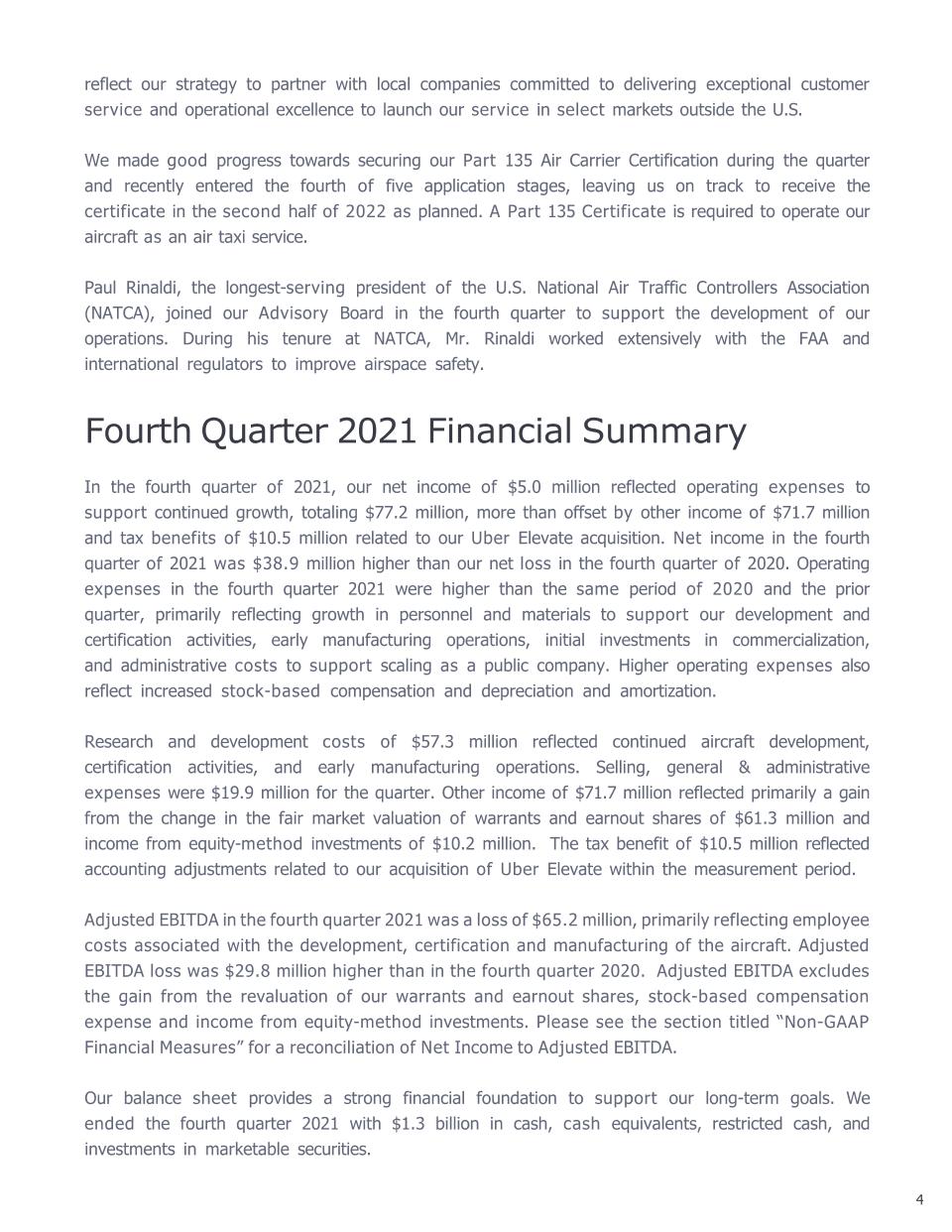
4 reflect our strategy to partner with local companies committed to delivering exceptional customer service and operational excellence to launch our service in select markets outside the U.S. We made good progress towards securing our Part 135 Air Carrier Certification during the quarter and recently entered the fourth of five application stages, leaving us on track to receive the certificate in the second half of 2022 as planned. A Part 135 Certificate is required to operate our aircraft as an air taxi service. Paul Rinaldi, the longest-serving president of the U.S. National Air Traffic Controllers Association (NATCA), joined our Advisory Board in the fourth quarter to support the development of our operations. During his tenure at NATCA, Mr. Rinaldi worked extensively with the FAA and international regulators to improve airspace safety. Fourth Quarter 2021 Financial Summary In the fourth quarter of 2021, our net income of $5.0 million reflected operating expenses to support continued growth, totaling $77.2 million, more than offset by other income of $71.7 million and tax benefits of $10.5 million related to our Uber Elevate acquisition. Net income in the fourth quarter of 2021 was $38.9 million higher than our net loss in the fourth quarter of 2020. Operating expenses in the fourth quarter 2021 were higher than the same period of 2020 and the prior quarter, primarily reflecting growth in personnel and materials to support our development and certification activities, early manufacturing operations, initial investments in commercialization, and administrative costs to support scaling as a public company. Higher operating expenses also reflect increased stock-based compensation and depreciation and amortization. Research and development costs of $57.3 million reflected continued aircraft development, certification activities, and early manufacturing operations. Selling, general & administrative expenses were $19.9 million for the quarter. Other income of $71.7 million reflected primarily a gain from the change in the fair market valuation of warrants and earnout shares of $61.3 million and income from equity-method investments of $10.2 million. The tax benefit of $10.5 million reflected accounting adjustments related to our acquisition of Uber Elevate within the measurement period. Adjusted EBITDA in the fourth quarter 2021 was a loss of $65.2 million, primarily reflecting employee costs associated with the development, certification and manufacturing of the aircraft. Adjusted EBITDA loss was $29.8 million higher than in the fourth quarter 2020. Adjusted EBITDA excludes the gain from the revaluation of our warrants and earnout shares, stock-based compensation expense and income from equity-method investments. Please see the section titled “Non-GAAP Financial Measures” for a reconciliation of Net Income to Adjusted EBITDA. Our balance sheet provides a strong financial foundation to support our long-term goals. We ended the fourth quarter 2021 with $1.3 billion in cash, cash equivalents, restricted cash, and investments in marketable securities.
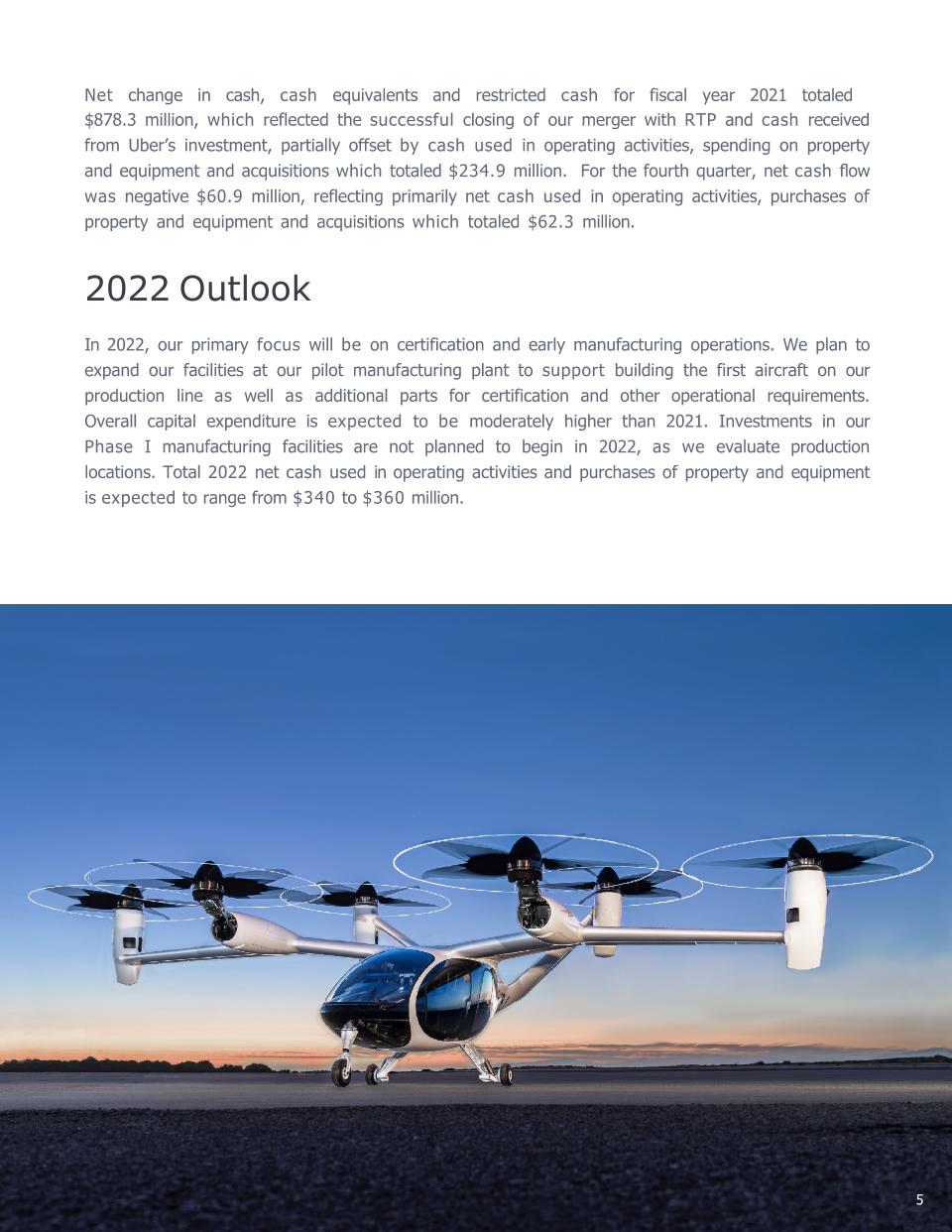
Net change in cash, cash equivalents and restricted cash for fiscal year 2021 totaled $878.3 million, which reflected the successful closing of our merger with RTP and cash received from Uber’s investment, partially offset by cash used in operating activities, spending on property and equipment and acquisitions which totaled $234.9 million. For the fourth quarter, net cash flow was negative $60.9 million, reflecting primarily net cash used in operating activities, purchases of property and equipment and acquisitions which totaled $62.3 million. 2022 Outlook In 2022, our primary focus will be on certification and early manufacturing operations. We plan to expand our facilities at our pilot manufacturing plant to support building the first aircraft on our production line as well as additional parts for certification and other operational requirements. Overall capital expenditure is expected to be moderately higher than 2021. Investments in our Phase I manufacturing facilities are not planned to begin in 2022, as we evaluate production locations. Total 2022 net cash used in operating activities and purchases of property and equipment is expected to range from $340 to $360 million. 5
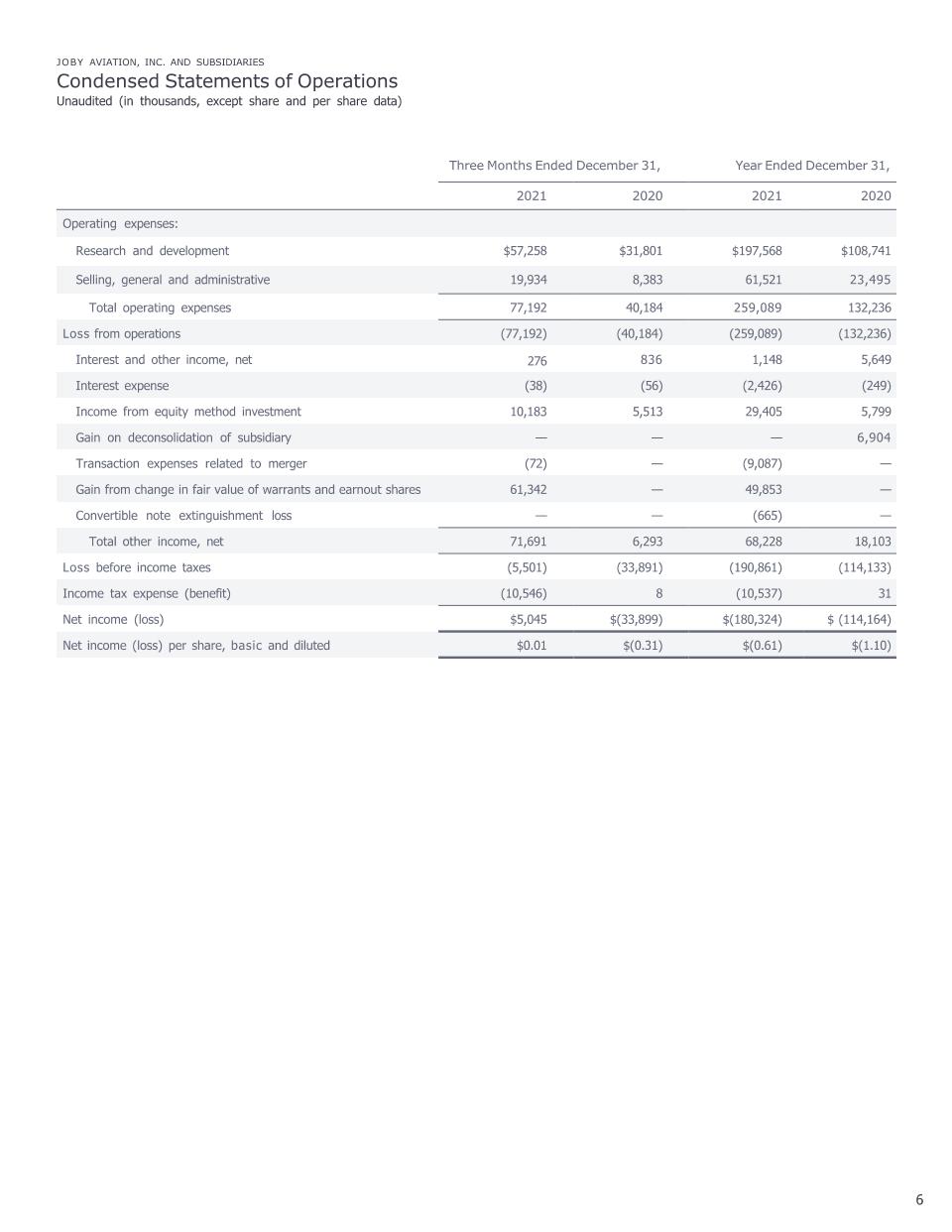
JOBY AVIATION, INC. AND SUBSIDIARIES Condensed Statements of Operations Unaudited (in thousands, except share and per share data) Three Months Ended December 31, Year Ended December 31, 2021 2020 2021 2020 Operating expenses: Research and development $57,258 $31,801 $197,568 $108,741 Selling, general and administrative 19,934 8,383 61,521 23,495 Total operating expenses 77,192 40,184 259,089 132,236 Loss from operations (77,192) (40,184) (259,089) (132,236) Interest and other income, net 276 836 1,148 5,649 Interest expense (38) (56) (2,426) (249) Income from equity method investment 10,183 5,513 29,405 5,799 Gain on deconsolidation of subsidiary — — — 6,904 Transaction expenses related to merger (72) — (9,087) — Gain from change in fair value of warrants and earnout shares 61,342 — 49,853 — Convertible note extinguishment loss — — (665) — Total other income, net 71,691 6,293 68,228 18,103 Loss before income taxes (5,501) (33,891) (190,861) (114,133) Income tax expense (benefit) (10,546) 8 (10,537) 31 Net income (loss) $5,045 $(33,899) $(180,324) $ (114,164) Net income (loss) per share, basic and diluted $0.01 $(0.31) $(0.61) $(1.10)
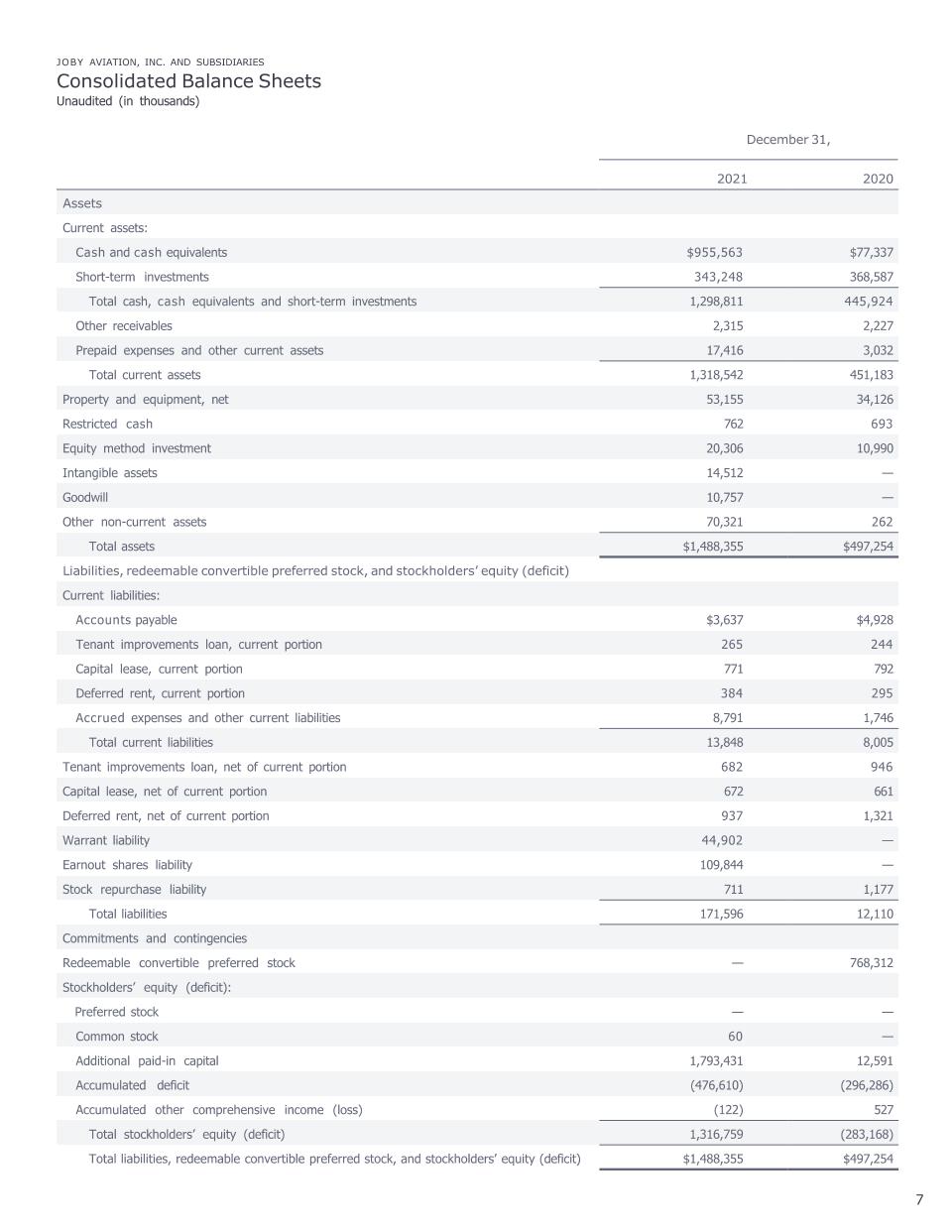
JOBY AVIATION, INC. AND SUBSIDIARIES Consolidated Balance Sheets Unaudited (in thousands) December 31, 2021 2020 Assets Current assets: Cash and cash equivalents $955,563 $77,337 Short-term investments 343,248 368,587 Total cash, cash equivalents and short-term investments 1,298,811 445,924 Other receivables 2,315 2,227 Prepaid expenses and other current assets 17,416 3,032 Total current assets 1,318,542 451,183 Property and equipment, net 53,155 34,126 Restricted cash 762 693 Equity method investment 20,306 10,990 Intangible assets 14,512 — Goodwill 10,757 — Other non-current assets 70,321 262 Total assets $1,488,355 $497,254 Liabilities, redeemable convertible preferred stock, and stockholders’ equity (deficit) Current liabilities: Accounts payable $3,637 $4,928 Tenant improvements loan, current portion 265 244 Capital lease, current portion 771 792 Deferred rent, current portion 384 295 Accrued expenses and other current liabilities 8,791 1,746 Total current liabilities 13,848 8,005 Tenant improvements loan, net of current portion 682 946 Capital lease, net of current portion 672 661 Deferred rent, net of current portion 937 1,321 Warrant liability 44,902 — Earnout shares liability 109,844 — Stock repurchase liability 711 1,177 Total liabilities 171,596 12,110 Commitments and contingencies Redeemable convertible preferred stock — 768,312 Stockholders’ equity (deficit): Preferred stock — — Common stock 60 — Additional paid-in capital 1,793,431 12,591 Accumulated deficit (476,610) (296,286) Accumulated other comprehensive income (loss) (122) 527 Total stockholders’ equity (deficit) 1,316,759 (283,168) Total liabilities, redeemable convertible preferred stock, and stockholders’ equity (deficit) $1,488,355 $497,254
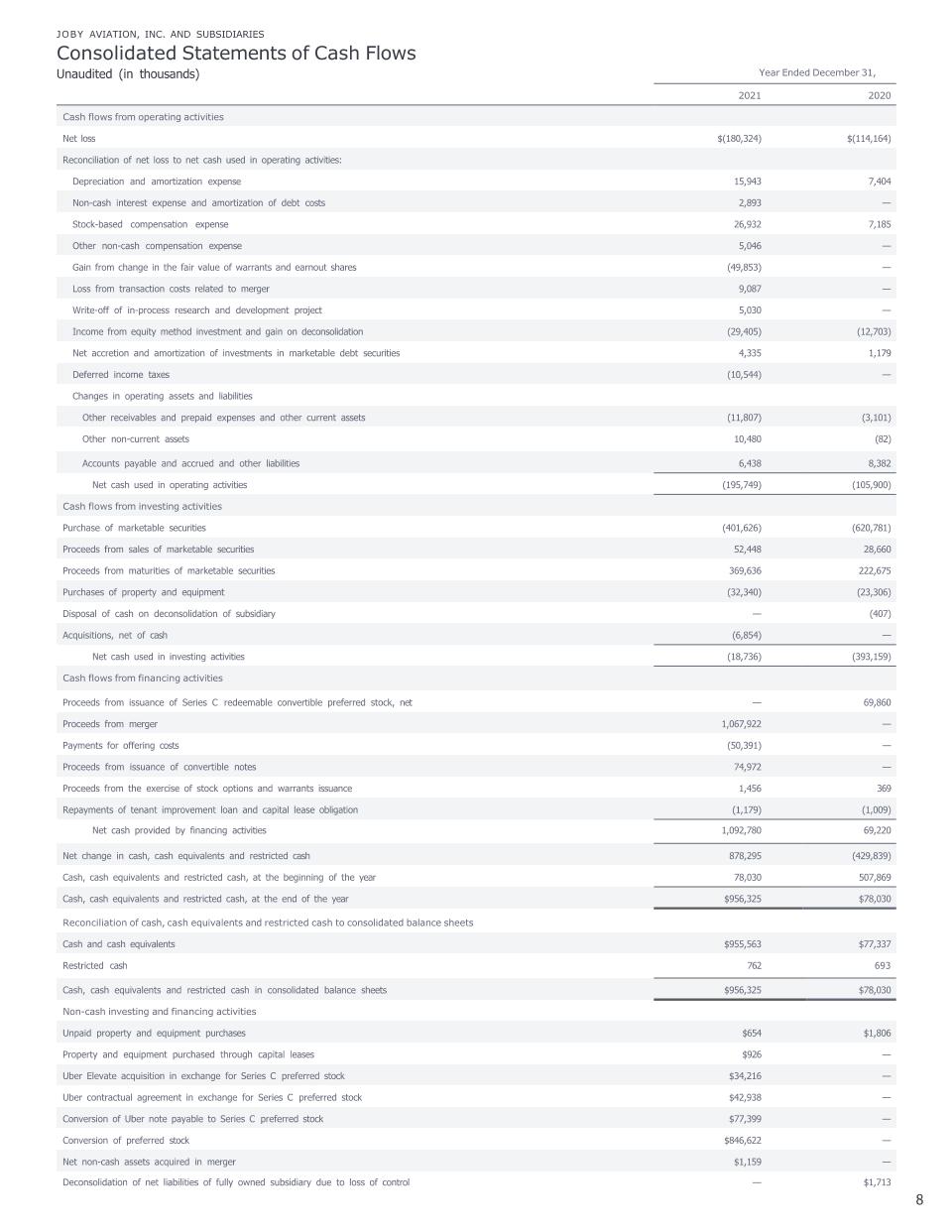
JOBY AVIATION, INC. AND SUBSIDIARIES Consolidated Statements of Cash Flows Unaudited (in thousands) Year Ended December 31, 2021 2020 Cash flows from operating activities Net loss $(180,324) $(114,164) Reconciliation of net loss to net cash used in operating activities: Depreciation and amortization expense 15,943 7,404 Non-cash interest expense and amortization of debt costs 2,893 — Stock-based compensation expense 26,932 7,185 Other non-cash compensation expense 5,046 — Gain from change in the fair value of warrants and earnout shares (49,853) — Loss from transaction costs related to merger 9,087 — Write-off of in-process research and development project 5,030 — Income from equity method investment and gain on deconsolidation (29,405) (12,703) Net accretion and amortization of investments in marketable debt securities 4,335 1,179 Deferred income taxes (10,544) — Changes in operating assets and liabilities Other receivables and prepaid expenses and other current assets (11,807) (3,101) Other non-current assets 10,480 (82) Accounts payable and accrued and other liabilities 6,438 8,382 Net cash used in operating activities (195,749) (105,900) Cash flows from investing activities Purchase of marketable securities (401,626) (620,781) Proceeds from sales of marketable securities 52,448 28,660 Proceeds from maturities of marketable securities 369,636 222,675 Purchases of property and equipment (32,340) (23,306) Disposal of cash on deconsolidation of subsidiary — (407) Acquisitions, net of cash (6,854) — Net cash used in investing activities (18,736) (393,159) Cash flows from financing activities Proceeds from issuance of Series C redeemable convertible preferred stock, net — 69,860 Proceeds from merger 1,067,922 — Payments for offering costs (50,391) — Proceeds from issuance of convertible notes 74,972 — Proceeds from the exercise of stock options and warrants issuance 1,456 369 Repayments of tenant improvement loan and capital lease obligation (1,179) (1,009) Net cash provided by financing activities 1,092,780 69,220 Net change in cash, cash equivalents and restricted cash 878,295 (429,839) Cash, cash equivalents and restricted cash, at the beginning of the year 78,030 507,869 Cash, cash equivalents and restricted cash, at the end of the year $956,325 $78,030 Reconciliation of cash, cash equivalents and restricted cash to consolidated balance sheets Cash and cash equivalents $955,563 $77,337 Restricted cash 762 693 Cash, cash equivalents and restricted cash in consolidated balance sheets $956,325 $78,030 Non-cash investing and financing activities Unpaid property and equipment purchases $654 $1,806 Property and equipment purchased through capital leases $926 — Uber Elevate acquisition in exchange for Series C preferred stock $34,216 — Uber contractual agreement in exchange for Series C preferred stock $42,938 — Conversion of Uber note payable to Series C preferred stock $77,399 — Conversion of preferred stock $846,622 — Net non-cash assets acquired in merger $1,159 — Deconsolidation of net liabilities of fully owned subsidiary due to loss of control — $1,713
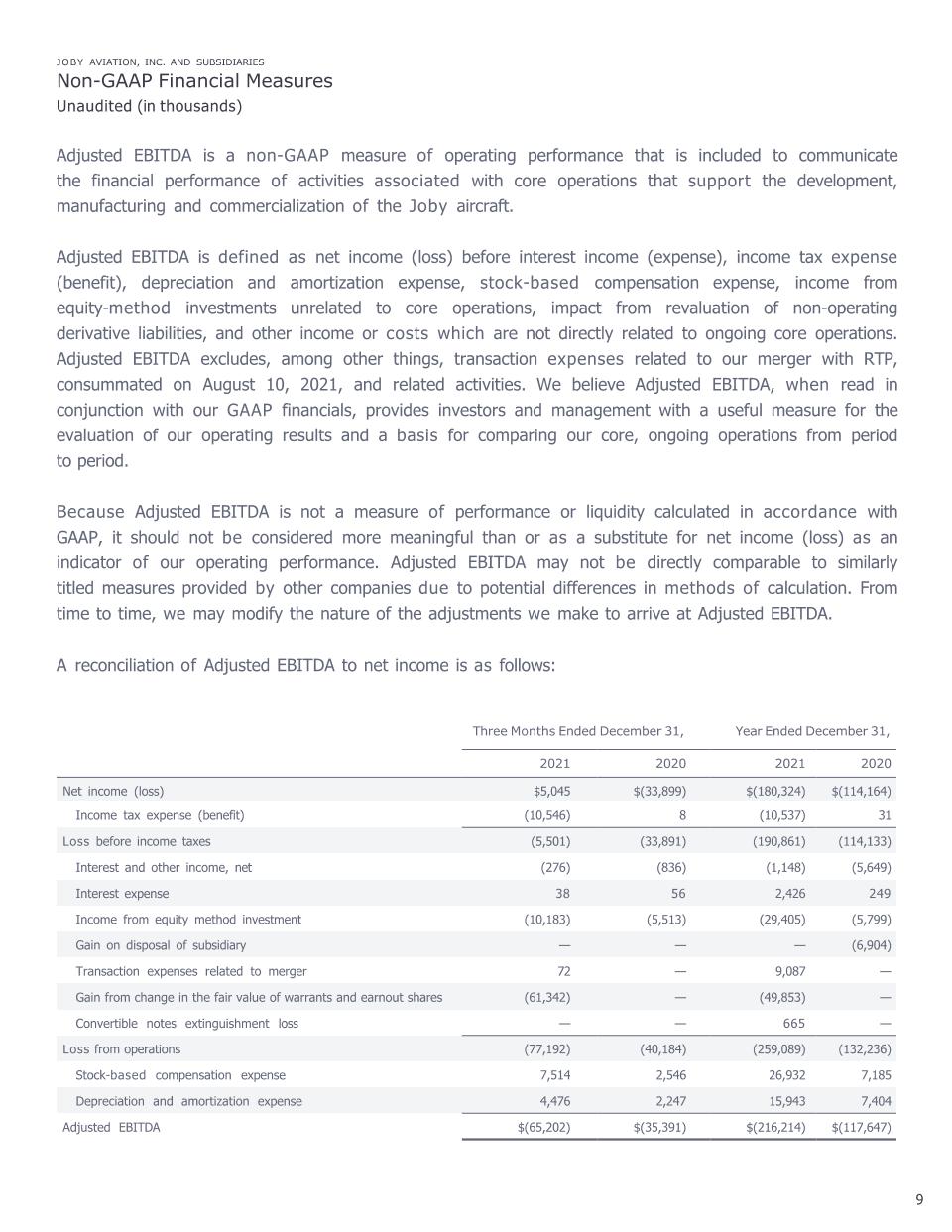
JOBY AVIATION, INC. AND SUBSIDIARIES Non-GAAP Financial Measures Unaudited (in thousands) Adjusted EBITDA is a non-GAAP measure of operating performance that is included to communicate the financial performance of activities associated with core operations that support the development, manufacturing and commercialization of the Joby aircraft. Adjusted EBITDA is defined as net income (loss) before interest income (expense), income tax expense (benefit), depreciation and amortization expense, stock-based compensation expense, income from equity-method investments unrelated to core operations, impact from revaluation of non-operating derivative liabilities, and other income or costs which are not directly related to ongoing core operations. Adjusted EBITDA excludes, among other things, transaction expenses related to our merger with RTP, consummated on August 10, 2021, and related activities. We believe Adjusted EBITDA, when read in conjunction with our GAAP financials, provides investors and management with a useful measure for the evaluation of our operating results and a basis for comparing our core, ongoing operations from period to period. Because Adjusted EBITDA is not a measure of performance or liquidity calculated in accordance with GAAP, it should not be considered more meaningful than or as a substitute for net income (loss) as an indicator of our operating performance. Adjusted EBITDA may not be directly comparable to similarly titled measures provided by other companies due to potential differences in methods of calculation. From time to time, we may modify the nature of the adjustments we make to arrive at Adjusted EBITDA. A reconciliation of Adjusted EBITDA to net income is as follows: Three Months Ended December 31, Year Ended December 31, 2021 2020 2021 2020 Net income (loss) $5,045 $(33,899) $(180,324) $(114,164) Income tax expense (benefit) (10,546) 8 (10,537) 31 Loss before income taxes (5,501) (33,891) (190,861) (114,133) Interest and other income, net (276) (836) (1,148) (5,649) Interest expense 38 56 2,426 249 Income from equity method investment (10,183) (5,513) (29,405) (5,799) Gain on disposal of subsidiary — — — (6,904) Transaction expenses related to merger 72 — 9,087 — Gain from change in the fair value of warrants and earnout shares (61,342) — (49,853) — Convertible notes extinguishment loss — — 665 — Loss from operations (77,192) (40,184) (259,089) (132,236) Stock-based compensation expense 7,514 2,546 26,932 7,185 Depreciation and amortization expense 4,476 2,247 15,943 7,404 Adjusted EBITDA $(65,202) $(35,391) $(216,214) $(117,647)
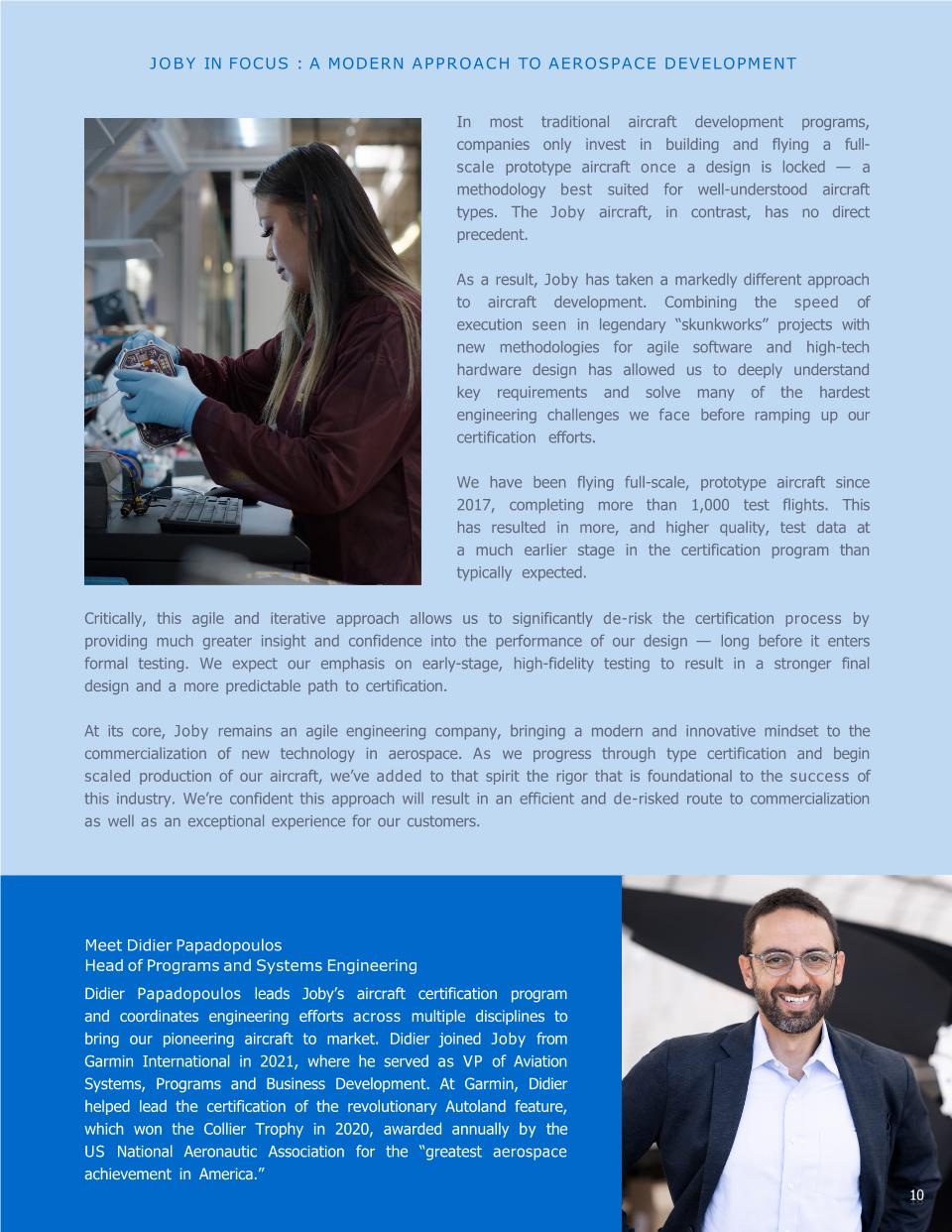
JOBY IN FOCUS : A MODERN APPROACH TO AEROSPACE DEVELOPMENT In most traditional aircraft development programs, companies only invest in building and flying a full- scale prototype aircraft once a design is locked — a methodology best suited for well-understood aircraft types. The Joby aircraft, in contrast, has no direct precedent. As a result, Joby has taken a markedly different approach to aircraft development. Combining the speed of execution seen in legendary “skunkworks” projects with new methodologies for agile software and high-tech hardware design has allowed us to deeply understand key requirements and solve many of the hardest engineering challenges we face before ramping up our certification efforts. We have been flying full-scale, prototype aircraft since 2017, completing more than 1,000 test flights. This has resulted in more, and higher quality, test data at a much earlier stage in the certification program than typically expected. Critically, this agile and iterative approach allows us to significantly de-risk the certification process by providing much greater insight and confidence into the performance of our design — long before it enters formal testing. We expect our emphasis on early-stage, high-fidelity testing to result in a stronger final design and a more predictable path to certification. At its core, Joby remains an agile engineering company, bringing a modern and innovative mindset to the commercialization of new technology in aerospace. As we progress through type certification and begin scaled production of our aircraft, we’ve added to that spirit the rigor that is foundational to the success of this industry. We’re confident this approach will result in an efficient and de-risked route to commercialization as well as an exceptional experience for our customers. Meet Didier Papadopoulos Head of Programs and Systems Engineering Didier Papadopoulos leads Joby’s aircraft certification program and coordinates engineering efforts across multiple disciplines to bring our pioneering aircraft to market. Didier joined Joby from Garmin International in 2021, where he served as VP of Aviation Systems, Programs and Business Development. At Garmin, Didier helped lead the certification of the revolutionary Autoland feature, which won the Collier Trophy in 2020, awarded annually by the US National Aeronautic Association for the “greatest aerospace achievement in America.” 10 10
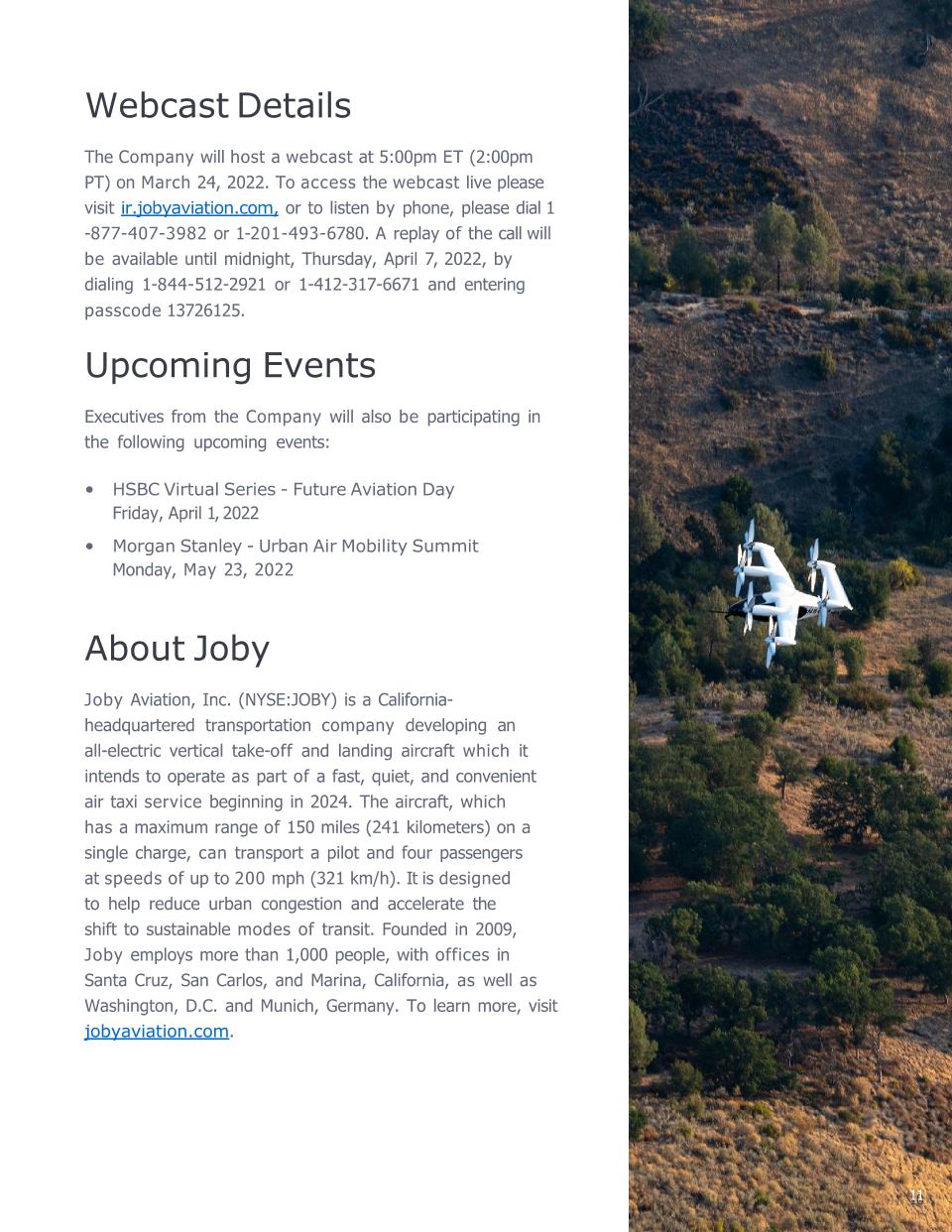
Webcast Details 10 11 The Company will host a webcast at 5:00pm ET (2:00pm PT) on March 24, 2022. To access the webcast live please visit ir.jobyaviation.com, or to listen by phone, please dial 1-877-407-3982 or 1-201-493-6780. A replay of the call will be available until midnight, Thursday, April 7, 2022, by dialing 1-844-512-2921 or 1-412-317-6671 and entering passcode 13726125. Upcoming Events Executives from the Company will also be participating in the following upcoming events: HSBC Virtual Series - Future Aviation Day Friday, April 1, 2022 Morgan Stanley - Urban Air Mobility Summit Monday, May 23, 2022 About Joby Joby Aviation, Inc. (NYSE:JOBY) is a California- headquartered transportation company developing an all-electric vertical take-off and landing aircraft which it intends to operate as part of a fast, quiet, and convenient air taxi service beginning in 2024. The aircraft, which has a maximum range of 150 miles (241 kilometers) on a single charge, can transport a pilot and four passengers at speeds of up to 200 mph (321 km/h). It is designed to help reduce urban congestion and accelerate the shift to sustainable modes of transit. Founded in 2009, Joby employs more than 1,000 people, with offices in Santa Cruz, San Carlos, and Marina, California, as well as Washington, D.C. and Munich, Germany. To learn more, visit jobyaviation.com.
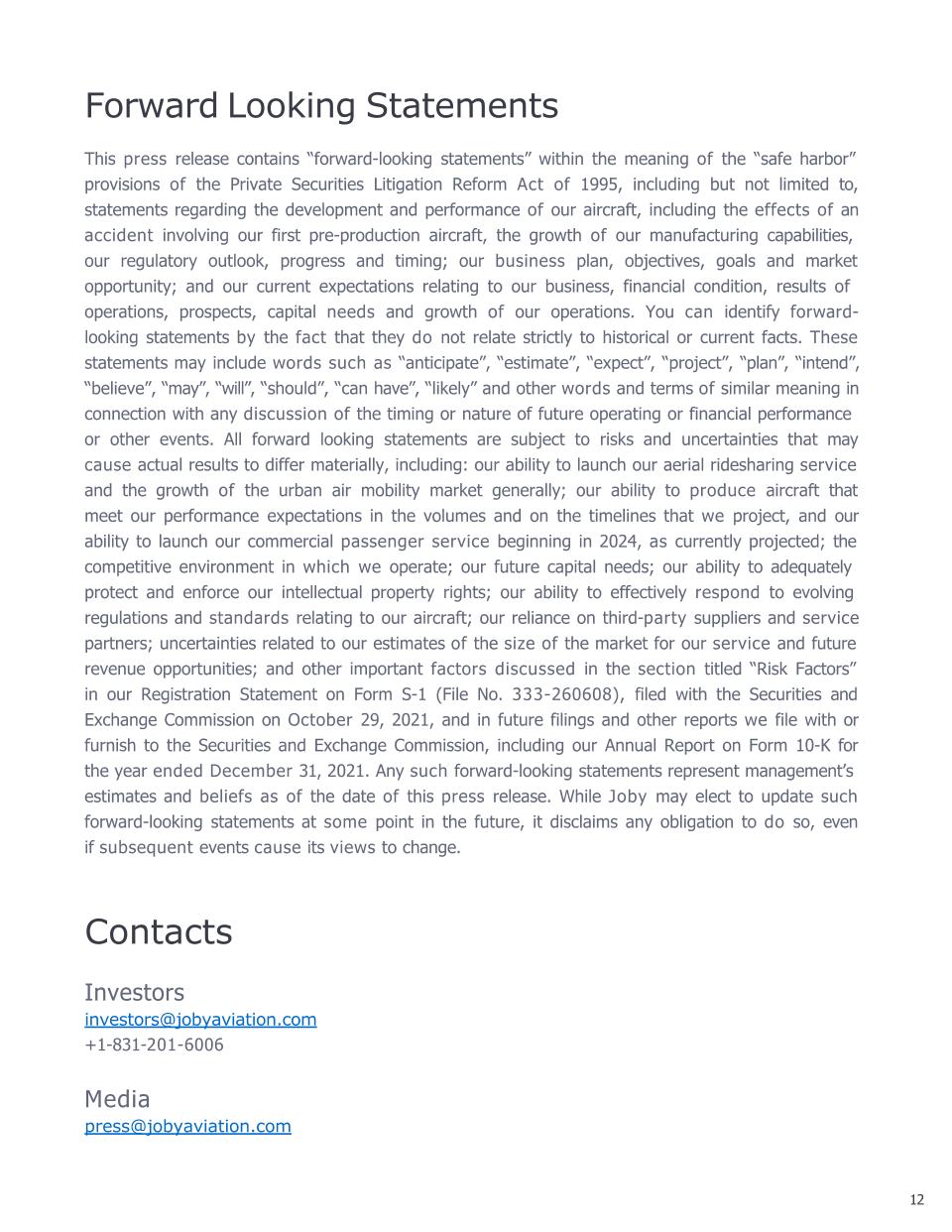
12 Forward Looking Statements This press release contains “forward-looking statements” within the meaning of the “safe harbor” provisions of the Private Securities Litigation Reform Act of 1995, including but not limited to, statements regarding the development and performance of our aircraft, including the effects of an accident involving our first pre-production aircraft, the growth of our manufacturing capabilities, our regulatory outlook, progress and timing; our business plan, objectives, goals and market opportunity; and our current expectations relating to our business, financial condition, results of operations, prospects, capital needs and growth of our operations. You can identify forward- looking statements by the fact that they do not relate strictly to historical or current facts. These statements may include words such as “anticipate”, “estimate”, “expect”, “project”, “plan”, “intend”, “believe”, “may”, “will”, “should”, “can have”, “likely” and other words and terms of similar meaning in connection with any discussion of the timing or nature of future operating or financial performance or other events. All forward looking statements are subject to risks and uncertainties that may cause actual results to differ materially, including: our ability to launch our aerial ridesharing service and the growth of the urban air mobility market generally; our ability to produce aircraft that meet our performance expectations in the volumes and on the timelines that we project, and our ability to launch our commercial passenger service beginning in 2024, as currently projected; the competitive environment in which we operate; our future capital needs; our ability to adequately protect and enforce our intellectual property rights; our ability to effectively respond to evolving regulations and standards relating to our aircraft; our reliance on third-party suppliers and service partners; uncertainties related to our estimates of the size of the market for our service and future revenue opportunities; and other important factors discussed in the section titled “Risk Factors” in our Registration Statement on Form S-1 (File No. 333-260608), filed with the Securities and Exchange Commission on October 29, 2021, and in future filings and other reports we file with or furnish to the Securities and Exchange Commission, including our Annual Report on Form 10-K for the year ended December 31, 2021. Any such forward-looking statements represent management’s estimates and beliefs as of the date of this press release. While Joby may elect to update such forward-looking statements at some point in the future, it disclaims any obligation to do so, even if subsequent events cause its views to change. Contacts Investors investors@jobyaviation.com +1-831-201-6006 Media press@jobyaviation.com
